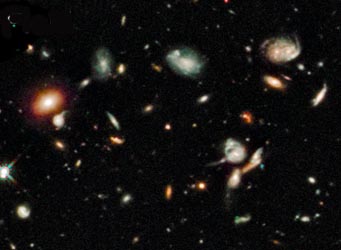As the limit of detectability gets pushed deeper and deeper into space, cosmologists know that the distant universe isn't what it appears to be.
The feeble light from ever-farther galaxies has been traveling for ever-longer times — and because the most distant objects are moving away from us the fastest, their light has also been redshifted the most. Brilliant beacons of ultraviolet light created by the first generations of hot stars reach Earth as dim glows in the infrared. To see these early suns (or rather whole galaxies of them), astronomers using the world's leading telescopes have probed as best they can. But they've struggled to break through the redshift limit of z = 7, corresponding to objects that formed some 800 million years after the Big Bang.

The Hubble Space Telescope's new Wide Field Camera 3 has taken the deepest image yet of the universe in near-infrared light. The faintest and reddest objects in the image are likely the oldest galaxies ever identified, being seen as they were only 600 to 900 million years after the Big Bang (at redshifts as high as 8). This small bit of the "Hubble Ultra Deep Field 09" is about 40 arcseconds across. Click here for a more detailed view, or here to download it at full resolution.
Kelly Beatty
Observers gained a formidable new tool last May, when spacewalking astronauts installed the Wide-Field Camera 3 into the belly of Hubble. Then they wasted little time taking its capabilities to the limit. During 12 days in late August and early September, the camera repeatedly stared at a tiny patch of sky, just 2 arcminutes square, in the constellation Fornax. It's the same area recorded five years ago in the Hubble Ultra-Deep Field (HUDF) image, which used the now-retired Advanced Camera for Surveys.
All told, WFC3 accumulated 173,000 seconds (48 hours) of exposure, yielding the deepest image ever taken in the infrared. The dimmest objects glow at magnitude 28.5, nearly a billion times fainter than the human eye could detect if we were equipped to see those wavelengths. More importantly, the new HUDF pushed deeper than ever into infrared territory, catching photons at 1.1, 1.25, and 1.65 microns.
Not surprisingly, researchers scrambled to get their hands on this new view. They hope to glimpse the transition from the infant universe's dark ages — when the hydrogen from the cooling Big Bang had not yet been ionized by star- and quasar-light and thus was opaque in the ultraviolet — to the reionization era, when the first stars lit up, ionized the intergalactic medium, and made it largely transparent.
Little is known about how or when reionization took place (except that it was probably spotty and irregular), so the rush is on to identify the most distant galaxies and thus the state of the universe at the earliest possible time. Within three months of the infrared HUDF's release, 12 papers had been been submitted for publication. Although hardly a wide-field image, it covers enough cosmic real estate to show a statistically meaningful sample of galaxies as they existed back then.
In one of these analyses, Andrew J. Bunker (Oxford University) and others find that aren't nearly enough galaxies at z=7 or older to reionize the hydrogen quickly enough. To get the job done, they conclude, many more galaxies must exist well below the detection limit, or the production of ionizing photons must be more efficient than theorized, or stars must have formed within these galaxies much more rapidly than expected.
For more background on this historic image, check out the press releases by the Space Telescope Science Institute, Europe's Hubble Information Center, and Oxford University.
 3
3
Comments
Mike McLoughlin
December 16, 2009 at 4:22 pm
Is there a limit to what we can see wrt red shifted light? The article seems to imply this but I am a newby at this. Also, if we see all these galaxies that are required for re ionization, what are the implications for new galaxy formation in the early universe? How fast can a galaxy form and how do we know that? Thanks!
You must be logged in to post a comment.
Bill
December 17, 2009 at 7:11 am
I just wanted to clarify that the ACS is not retired. STS-125 went to heroic efforts to bring it back to life. WFC3 has unique IR capabilities, making this observation even better than the previous ACS one.
You must be logged in to post a comment.
CDM
December 18, 2009 at 1:51 pm
I'm not sure why this image claims to go "deeper than ever into infrared territory". The NICMOS instrument was used to compile the original Ultra-Deep Field image at wavelengths out to 1.6 microns -- the same as the WFC3 IR channel. It's true that WFC3's resolution is higher, but unless I'm missing something, it doesn't go deeper into the IR.
You must be logged in to post a comment.
You must be logged in to post a comment.